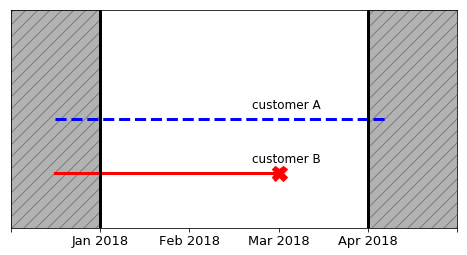Introduction to Survival Analysis
Introduction
Survival analysis is used to analyze or predict when an event is likely to happen. It originated from medical research, but its use has greatly expanded to many different fields. For instance:
- banks, lenders and other financial institutions use it to compute the speed of repayment of loans or when a borrower will default
- businesses adopt it to calculate their customers LTV (lifetime value) or when a client will churn
- companies use it to predict when employees will decide to leave
- engineers/manufacturers apply it to predict when a machine will break
Censoring: why regression models cannot be used?
The real strength of Survival Analysis is its capacity to handle situations when the event has not happened yet. To illustrate this, let's take the example of two customers of a company and follow their active/churn status between January 2018 and April 2018:
- customer A started doing business prior to the time window, and as of April 2018, is still a client of the company.
- customer B also started doing business before January 2018, but churned in March 2018.
 |
Here, we have an explicit depiction of the event for customer B. However, we have no information about customer A, except that he/she hasn't churned yet at the end of the January 2018 to April 2018 time window. This situation is called censoring.
One might be tempted to use a regression model to predict when events are likely to happen. But to do that, one would need to disregard censored samples, which would result in a loss of important information. Fortunately, Survival models are able to take censoring into account and incorporate this uncertainty, so that instead of predicting the time of event, we are predicting the probability that an event happens at a particular time .
Data format
We characterize survival analysis data-points with 3 elements: , ,
- is a p−dimensional feature vector.
- is the event indicator such that , if an event happens and in case of censoring.
- is the observed time, with the actual event time and the time of censoring.
This configuration differs from regression modeling, where a data-point is defined by and is the target variable. This means that to fit a model, you will need to provide those 3 elements.
Let's look at the difference between a regression model fit and survival analysis one:
| Modeling type | code |
|---|---|
| Regression model using sklearn | |
| Survival analysis using pysurvival | |